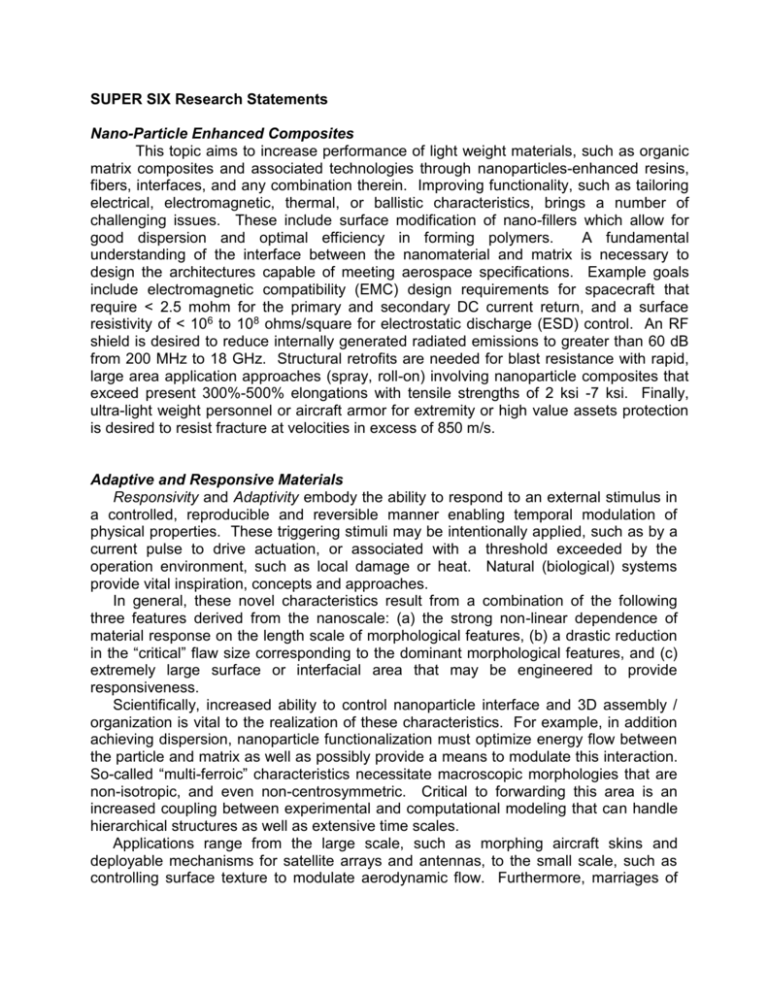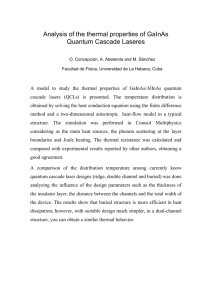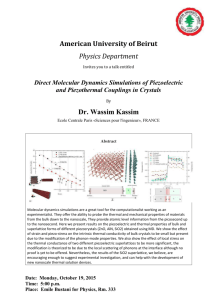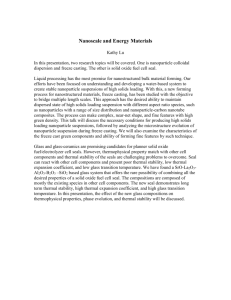DISCUSSION GROUP SUMMARIES
advertisement

SUPER SIX Research Statements Nano-Particle Enhanced Composites This topic aims to increase performance of light weight materials, such as organic matrix composites and associated technologies through nanoparticles-enhanced resins, fibers, interfaces, and any combination therein. Improving functionality, such as tailoring electrical, electromagnetic, thermal, or ballistic characteristics, brings a number of challenging issues. These include surface modification of nano-fillers which allow for good dispersion and optimal efficiency in forming polymers. A fundamental understanding of the interface between the nanomaterial and matrix is necessary to design the architectures capable of meeting aerospace specifications. Example goals include electromagnetic compatibility (EMC) design requirements for spacecraft that require < 2.5 mohm for the primary and secondary DC current return, and a surface resistivity of < 106 to 108 ohms/square for electrostatic discharge (ESD) control. An RF shield is desired to reduce internally generated radiated emissions to greater than 60 dB from 200 MHz to 18 GHz. Structural retrofits are needed for blast resistance with rapid, large area application approaches (spray, roll-on) involving nanoparticle composites that exceed present 300%-500% elongations with tensile strengths of 2 ksi -7 ksi. Finally, ultra-light weight personnel or aircraft armor for extremity or high value assets protection is desired to resist fracture at velocities in excess of 850 m/s. Adaptive and Responsive Materials Responsivity and Adaptivity embody the ability to respond to an external stimulus in a controlled, reproducible and reversible manner enabling temporal modulation of physical properties. These triggering stimuli may be intentionally applied, such as by a current pulse to drive actuation, or associated with a threshold exceeded by the operation environment, such as local damage or heat. Natural (biological) systems provide vital inspiration, concepts and approaches. In general, these novel characteristics result from a combination of the following three features derived from the nanoscale: (a) the strong non-linear dependence of material response on the length scale of morphological features, (b) a drastic reduction in the “critical” flaw size corresponding to the dominant morphological features, and (c) extremely large surface or interfacial area that may be engineered to provide responsiveness. Scientifically, increased ability to control nanoparticle interface and 3D assembly / organization is vital to the realization of these characteristics. For example, in addition achieving dispersion, nanoparticle functionalization must optimize energy flow between the particle and matrix as well as possibly provide a means to modulate this interaction. So-called “multi-ferroic” characteristics necessitate macroscopic morphologies that are non-isotropic, and even non-centrosymmetric. Critical to forwarding this area is an increased coupling between experimental and computational modeling that can handle hierarchical structures as well as extensive time scales. Applications range from the large scale, such as morphing aircraft skins and deployable mechanisms for satellite arrays and antennas, to the small scale, such as controlling surface texture to modulate aerodynamic flow. Furthermore, marriages of materials and structural design that enable non-rigid robotics, such as those that mimic octopi, provide key capabilities for search & rescue and special operations. Finally, these “smart systems” are enabled by many types of “smart” / “self-sensing” materials, including compliant electrodes, piezo-resistive elastomers, photo-triggered actuators, etc. Nano Energetics Energetic materials are compounds that exothermically release energy at an extremely rapid or controllable rate in deflagration, detonation, or thermitic reactions upon an initiation stimulus or input. They are critical for many AF applications, including munitions, air-breathing propulsion, and spacelift. Nanotechnology has the potential to provide revolutionary capabilities by using the energetic nanostructure to control the reaction energies, products, and rates. For example, reactive metal particles have shown promise in changing the reaction rates for munitions applications while nanoparticle-fuel additives could provide capabilities in thermal transport, signature control, efficiency, and reaction rates. Nanostructured propellants have the potential to improve the specific impulse and efficiency of spacelift engines with significant advantages in performance, safety, cost, and structural properties. Coupling of nanoenergetic materials with MEMS devices for controllable energy release is also of interest. Design and search for synthetic techniques must be enhanced by realistic modeling at both atomic (reaction heats and activation barriers) and mesoscale (particle shape, morphology, and stabilization). Also of interest is the development of specific small-volume analytical techniques. Power Generation and Storage Hybrid Nanomaterials for Multifunctional Power Generation and Storage Nanoscience and technology approaches are being pursued to advance a number of power technologies, such as solar cells; superconducting generator windings, permanent magnets for power generation and utilization, power conditioning devices; energy storage devices; and energy harvesting through thermoelectric/thermionic and piezoelectric means. Nanostructured materials exhibit unique optical, mechanical, thermal, magnetic and electrical properties. Novel combinations of these properties will lead to otherwise unachievable performance. For instance, nanoscale defects embedded in superconducting materials work to maintain high current densities that are normally compromised in the presence of high magnetic fields. These nanoscale defects immobilize the vortices generated by the magnetic fields, thus allowing the current to flow without resistance. Expected benefits from these systems include higher power conversion efficiencies of solar cells, higher power and energy densities of next-generation batteries, lighter-weight alternatives to high energy density capacitor systems, more efficient fuel cell systems and “self-powered” loadbearing structures with integrated energy harvest/storage capabilities. These approaches will enable new capabilities for the Air Force and will provide reduced cost and size of power conditioning devices; enhanced safety and improved reliability of batteries for ground, air and space; compact power for high power applications; higher power for satellites, and dramatic improvements in system-level efficiency. Sensors Electromagnetic sensors This topic includes development of quantum engineered materials and devices for high performance sensing and communication. Materials and structures are required which can be exploited to produce uncooled sensors for diagnostic and surveillance applications, especially in conformal and flexible platforms with device or wafer-level encapsulation schemes. This topic also includes nanosensors embedded into multi-functional systems and the associated problems with interfacing such nanometer-scale sensors to the outside world. For example, materials utilizing quantum effects from electrons confined in 1, 2, or 3 dimensions on scales of 100 nm or less offer new capabilities in optical detector design and performance. Quantum based semiconductor materials can be designed to selectively cover a large portion of the optical spectrum, from ultraviolet wavelengths (10 to 400 nm) to very long infrared wavelengths (15 to 30 microns), which can provide hyperspectral sensitivity and polarization selectivity. These materials could potentially find uses in the cross over region from photon detection to electromagnetic detection, which occurs at terahertz (THz) frequencies. Quantum confined materials enable the ability to manipulate and enhance the optical, electrical, thermal, and noise mechanisms to optimize device performance. Also, in order to optimize sensor performance, it is necessary to consider system architectures. For active sensors, source and detector performance must be considered as part of a coordinated sensing system. Narrowband tunable optical sources will provide higher sensitivity for remote optical detection. Coherent detection techniques, which can be implemented using nanostructured materials such as metamaterials or using optoelectronic solutions in the terahertz regime, depend on the use of a coupled source-detector combination. Thermal Management It is widely acknowledged that thermal management remains a critical but generally unexplored issue as devices get smaller and the need for expelling heat and managing small heat loads intensifies. A fundamental understanding must be gained on thermal transport issues, such as moving, storing, switching, reusing and transforming heat. This, in turn, leads to an investigation of the thermal conductivity and emissivity of materials and devices where basic surface chemistry must be understood to be able to thermally manage and design systems. One approach would include multiscale modeling and simulation theory by verifying and validating models and I/O impedance from level to level, atomistically and to system-to-systems. Scaling laws for thermal management, such as the thermal continuum application at the nanoscale level, must be considered. Similarly, the lower limit of thermodynamic size which one can posit a thermo cycle must be established. Heat dissipation of > 2 Watts/in2 and chip junction temperature < 125oC are desired in some high power microelectronics applications. Nanofluid systems need to be operational in the temperature range from 40oC to 200oC. Also, thermoelectric targets from DARPA include higher efficiencies (ZT > 2) at a broader operational temperature range (0oC-300oC) at which nanocomposites could address. Additionally, materials with controlled directional thermal conductivity which can handle thermal fluxes up to 1000 W/cm 2 over large areas and phase change materials which can enable thermal energy storage on the order of 1000 kJ/kg are needed.








